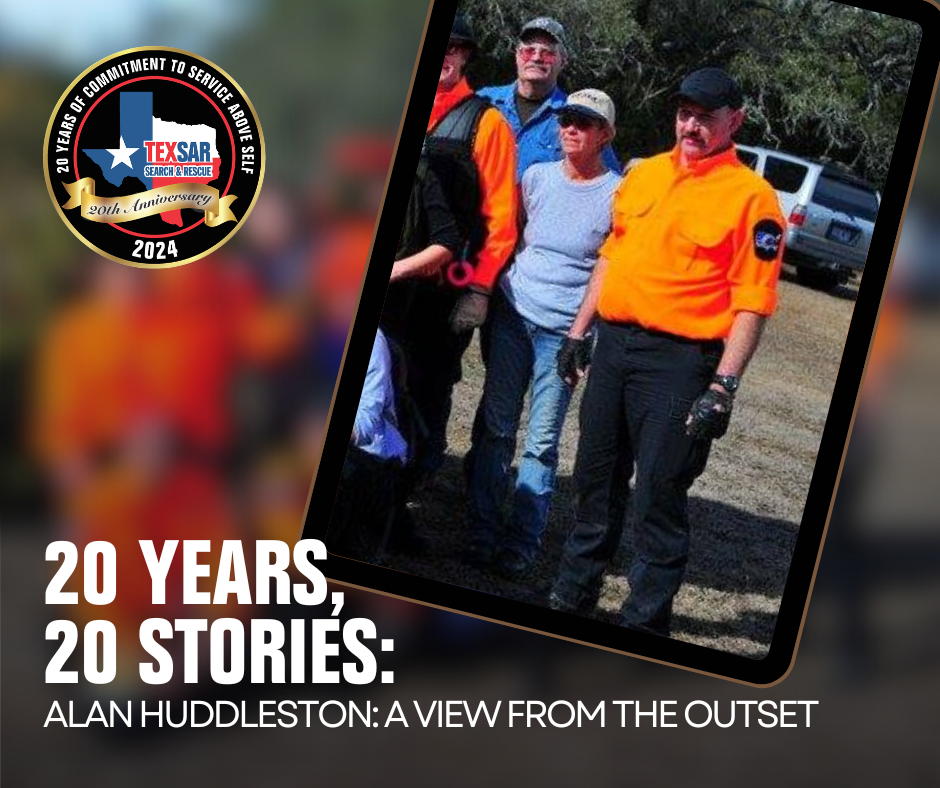20 Years, 20 Stories – Alan Huddleston: A View from the Outset

Years Active: 2004-2022
Alan Huddleston has a special perspective of TEXSAR’s beginnings. He has been there from the outset; he has seen a lot of changes in the organization, and a constant thread that has run throughout its history. Together, change and constancy has created a unique formula for success.
He can cite the many steps from the earliest beginnings when the quest to develop a search-and-rescue team led to the formation of an Austin-area chapter of the Civil Air Patrol (CAP). He can detail a myriad of changes through which a constant emphasis remained: training. They based their early training on programs of CAP and other proven models. “We developed the training program for the State Firemen’s and Fire Marshal’s Association,” he said.
“We developed a great training program. Other organizations and businesses have picked up our training techniques. We developed a concept of a 24-hour pack that included the things a volunteer would likely need if away from resources for 24 hours,” Alan said. He remembers an early deployment for Hurricane Emily (2005) when the volunteers stayed in a jail for housing and “We had to make our 24-hour packs last for two days,” he said.
There are many highly recognized stories of TEXSAR successes, but TEXSAR was not always on the radar. “In the early days, we spent a lot of time searching down ‘Google balloons’ (part of Google’s Project Loon) back when they used them to distribute internet access to rural and remote areas. Eventually, they would come down and we would find them.”
TEXSAR volunteers were involved in a find of another kind that brought the organization into the national limelight. Arkansas Democrat-Gazette reporter Cathy Frye went missing in Big Bend. She was with her husband, photojournalist Rick McFarland, when they got lost. He went looking for help after she could no longer travel and luckily was able to get to a ranger station. A search began and she was found with only hours left to live, according to reports. TEXSAR played a key role in that search. It was that deployment that led to the change in TEXSAR uniforms from tan colored to highly recognizable blaze orange. “The people in the helicopters couldn’t see our volunteers in our uniforms,” Alan said, “so we made the change.”
About two years later, TEXSAR was highly acclaimed in a major event, the Memorial Day Wimberley Flood Event. The acclaim is not something the volunteers ever seek, Alan said. “We do what we do to serve others.” He admits to being proud of having received an award from the Austin Fire Department for racing across lanes of highway traffic to help others after a major wreck. “We are trained to always be prepared and I was able to help that day because of preparation in training and equipment in my car,” he said.
Some opportunities are fast and spontaneous, and some are more enduring. “After Hurricane Ike, we were on Bolivar (peninsula) for three weeks. We learned a lot about the smell of rotting carcasses of cows, horses and alligators. In emergencies and disasters, you never know everything you will encounter,” he said. He recounts how a TEXSAR team deployed to help after Hurricane Katrina but were turned back because there was shooting at the site they were scheduled to go to.
“It has been an adventure, working for FEMA and volunteering with TEXSAR over the years. When I retire, I plan on moving to Puerto Rico to create a resort in the mountains that celebrates Puerto Rican art and culture.”
Learn more about TEXSAR at www.TEXSAR.org.
TEXSAR: 20 Years, 20 Stories, is a series of people-centric stories that celebrate the history of TEXSAR’s heroics and humanity as its volunteers continue their mission of ‘Texans helping Texans’ with Service above Self. The sequence of stories and profiles will come together in 2024 and 2025, celebrating the nonprofit’s 20th anniversary. To read more, click here.


